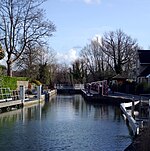Osney Lock Hydro
Osney Lock Hydro is a micro hydroelectric scheme in Oxford, England. It is located on the River Thames, using the head of water provided by the weir at Osney Lock. It can generate 49 kilowatts (66 hp) of electricity with its archimedes screw turbine. Between 2015 and 2020 the scheme generated an average of 188 megawatt-hours (680 GJ) a year of electricity, which is enough to power around 60 homes.The scheme is owned and operated by Osney Lock Hydro, an industrial and provident society for the benefit of the community. The idea for the project was first raised in 2002, with construction work starting in the summer of 2013, and the first electricity was generated in May 2015.
Excerpt from the Wikipedia article Osney Lock Hydro (License: CC BY-SA 3.0, Authors).Osney Lock Hydro
Bridge Street, Oxford Osney
Geographical coordinates (GPS) Address Nearby Places Show on map
Geographical coordinates (GPS)
| Latitude | Longitude |
|---|---|
| N 51.7496 ° | E -1.2727 ° |
Address
Bridge Street
Bridge Street
OX2 0DH Oxford, Osney
England, United Kingdom
Open on Google Maps









